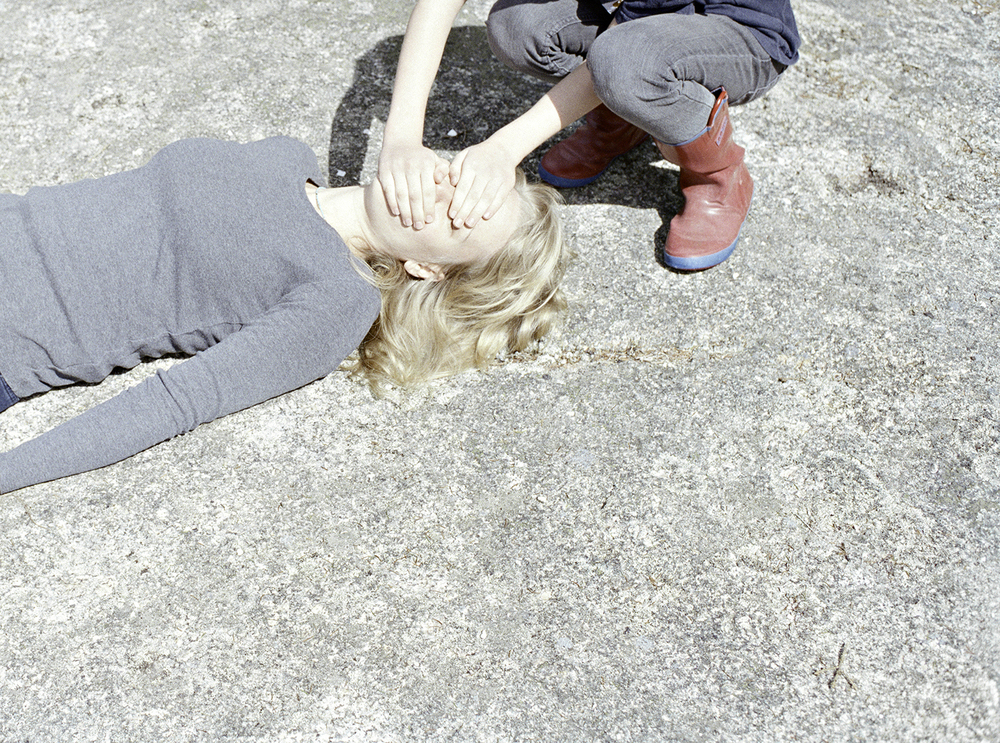Sophie Barbasch’s Fault Line
This week I spoke with thoughtful New York City-based artist Sophie Barbasch about isolation, intimacy and family.
Liz Sales: I’ve just finished reading about your recent photographic project, Fault Line, and I had some additional questions about it and your work in general. For instance, you mentioned that you collaborated on this project with your cousins. What was their level of involvement?
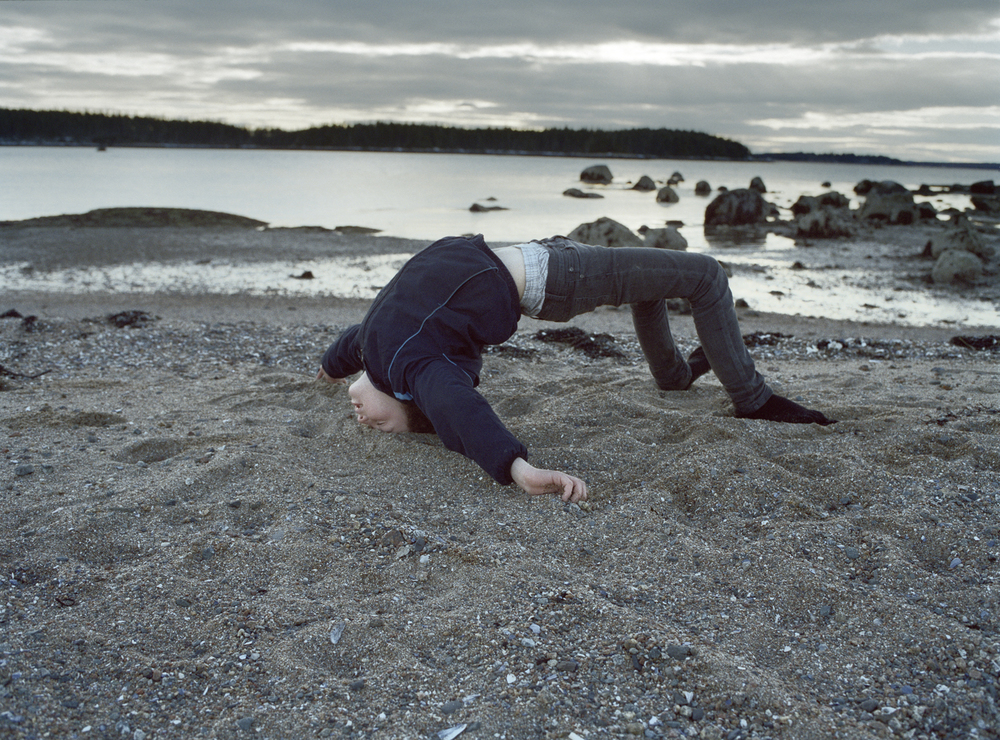
Horizon, 2013
Sophie Barbasch I started Fault Line in March 2013. Since then, I’ve been going up to Maine about three times a year to shoot. My cousin Adam helps me come up with ideas and he is a willing model, even in sub-zero temperatures. He’s young but he’s very intuitive about photography. My other cousin, Wes, is also game for anything–he scouts locations with me, poses for photos, and gives me the extra encouragement to take pictures. They tease me about asking them to do weird things for photos, like lie down in tide pools, swamps, and other similarly unappealing stuff. I usually laugh for a minute and then seriously propose that they go ahead and sit in the tidepool. Sometimes they agree! I show them my shot lists, contact sheets, and finished photos, and they help me figure out what works and what’s missing.
LS There is a sense of loneliness and isolation in these images.
SB Yes, I try to use formal elements to convey that people are not connecting. I stage subjects as if they are shut out of the house or alone on the road with no car in sight. They face away from the camera and they don’t look at each other. Sometimes, their eyes are closed or they are alone in the frame. When people do touch, I try to make it ambiguous. For example, in one picture, Sun Spots, Adam is holding my eyes and mouth in a way that could either be interpreted as caring or coercive. In another, “Junkyard,” Wes hugs Adam from behind. They are in a weird field, and it’s late in the day. The gesture seems like it could be protective, but because of the surroundings and the fact that neither of them is facing the camera, it’s not totally clear.
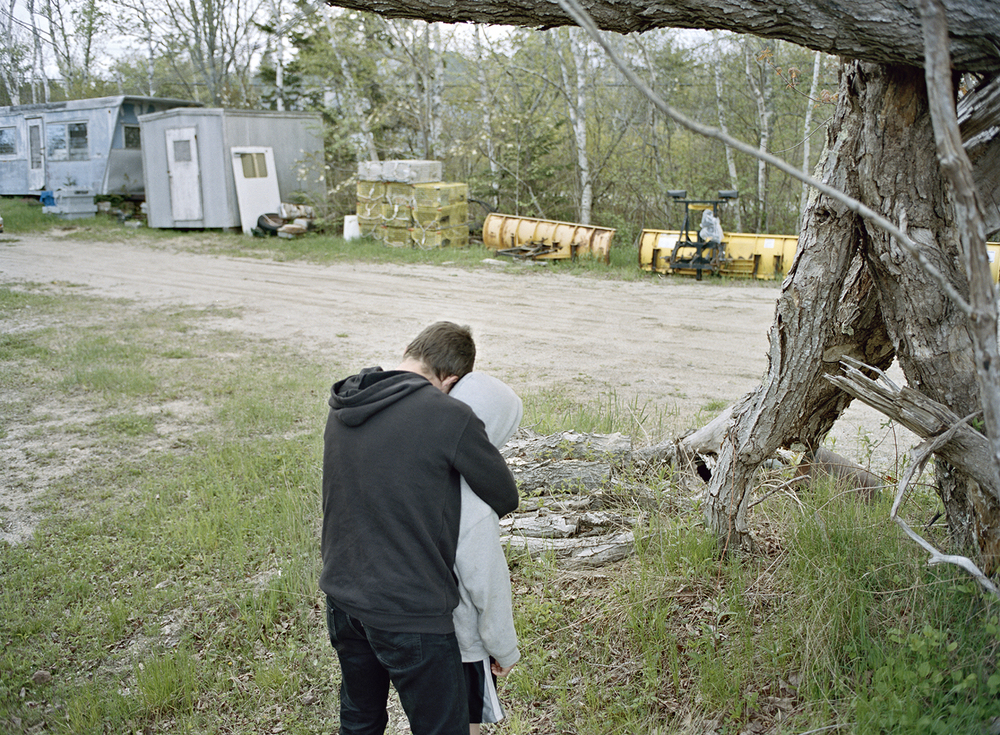
Junkyard, 2014
LS Why do you think you feel so disconnected?
SB I’m not sure if I’m more isolated than the next person or if I just think about it more. But I have experienced a lot of conflict in my immediate family. I was estranged from my dad for a while. Also, some of my immediate family relocated to Brazil, so there have been various separations over the years.
LS Is this project a way of bridging your sense of isolation by connecting to your cousins?
SB Yes, definitely. It’s comforting that we get along and we can share the experience of our particular upbringing. I think this is true of any group of family members, or anyone you’re close to–you don’t have to explain the backstory. There’s room for nuance in our relationships and in our perceptions of each other because we know all the details. Another way that this project helps diminish the isolation is that it directly involves all of us in the same creative endeavor.
LS Intimacy and a lack thereof is one of your overall themes. Is your performance project, I will read to you, still active? If I write readastorytome@gmail.com, will you email me a recording?
SB Yes, it is!
Sophie read me The Selfish Giant by Oscar Wilde
LS That’s great! I’m going to write you and ask you to read me a story. Is Goodnight Call still active as well?
SB It’s still active, though I haven’t checked the voicemail service associated with it in a while.
LS Do you want me to call you and wish you good night? Or are you specifically soliciting calls from men?
SB It’s usually gender specific, but I always welcome calls.
LS But your work does seem to explore something about gender relationships?
SB I needed to figure out some stuff about men.
LS Like what?
Goodnight Call, 2011, single channel video, 00:04:32
SB I made Goodnight Call right after a breakup. I wanted to know why the breakup happened, how it happened, and where it went wrong. I was spending a lot of time thinking about relationships in general, and I had the idea that if I could build a fake relationship in the context of an art project, I would gain some understanding about how real ones work. I was thinking about the arc, or phases, of a relationship. In its finished form, the piece is a 4-minute audio track of strangers from Craigslist pretending to be my boyfriend and wishing me goodnight. It exists both as a video and as an audio installation. In the process, I went through a lot of different questions and received about 300 messages over the span of 8 months. I asked for apologies, confessions, marriage proposals, dreams, encouragement, forgiveness–pretty much everything except a breakup message. I wanted insight into this random sampling of men, their motivations, their emotions, etc. In this sense, the project was about learning. My books also relate to this search for knowledge. The set of books is titled Training to be a girl and each one looks like a plain textbook.
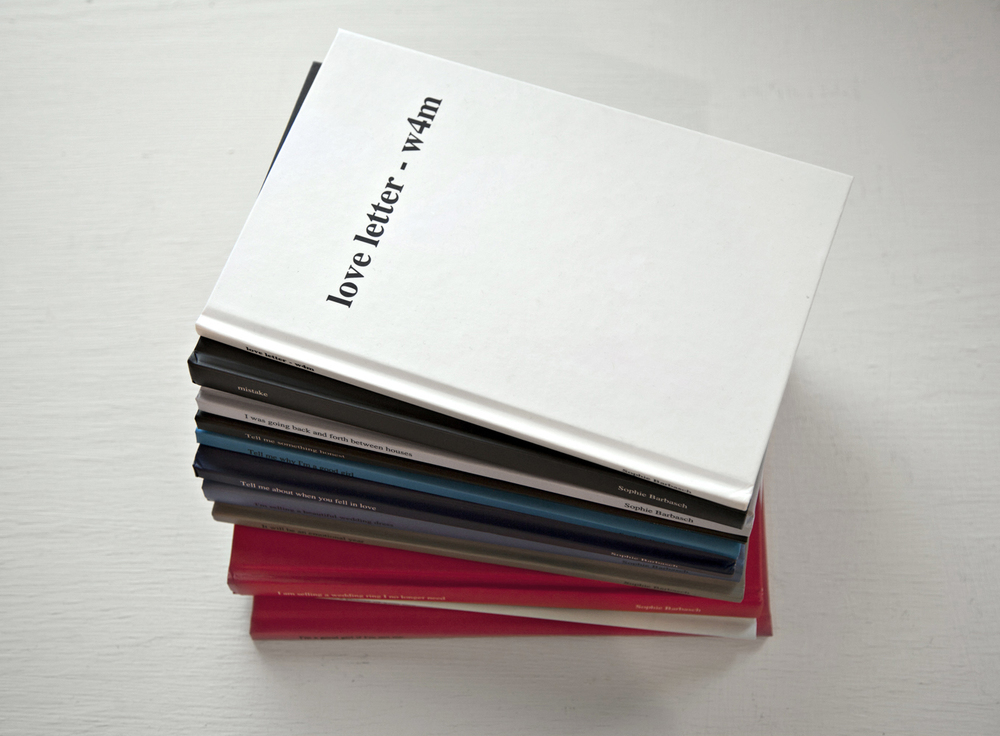
Training to be a Girl, 2013
LS What did you learn about the dynamic between men and women?
SB Not to sound too cheesy, but mostly that we are strikingly similar. This was actually a surprise to me. Asking questions and making demands was a way for me to assert power. In the process, I came to empathize with these strangers who were willing to tell me things. The questions I asked came from my own vulnerabilities and obsessions, and the guys mirrored them back, reflected on them, and related to them. Though I did not become pen-pals with anyone, or even reveal my identity, I think the project is still an exchange–if not between me and the men then perhaps between the viewer / listener / reader and the men.
I have a new book called Women find love easily in which men from Craigslist sound off on whether or not they should be scared of women. They contradict each other a lot. But that is the point of the project. I am asking questions that don’t have real answers. My larger aim is to point at the futility of asking these types of questions. For example, the question behind my Craigslist-solicited, text-based book Tell me why I’m a good girl is a ruse, but the men who responded answered my question sincerely.
LS I know, I was surprised by how seriously they took your request.
SB That was my point: to get them to voice these really terrible stereotypes. It was important that the framework allowed them to think they were being constructive and helpful. This mimics a certain unfortunate, patronizing element that I encounter in my daily life. With this book, I was still playing a damsel-in-distress, but I was also trying to subvert the power dynamic and control the conversation.
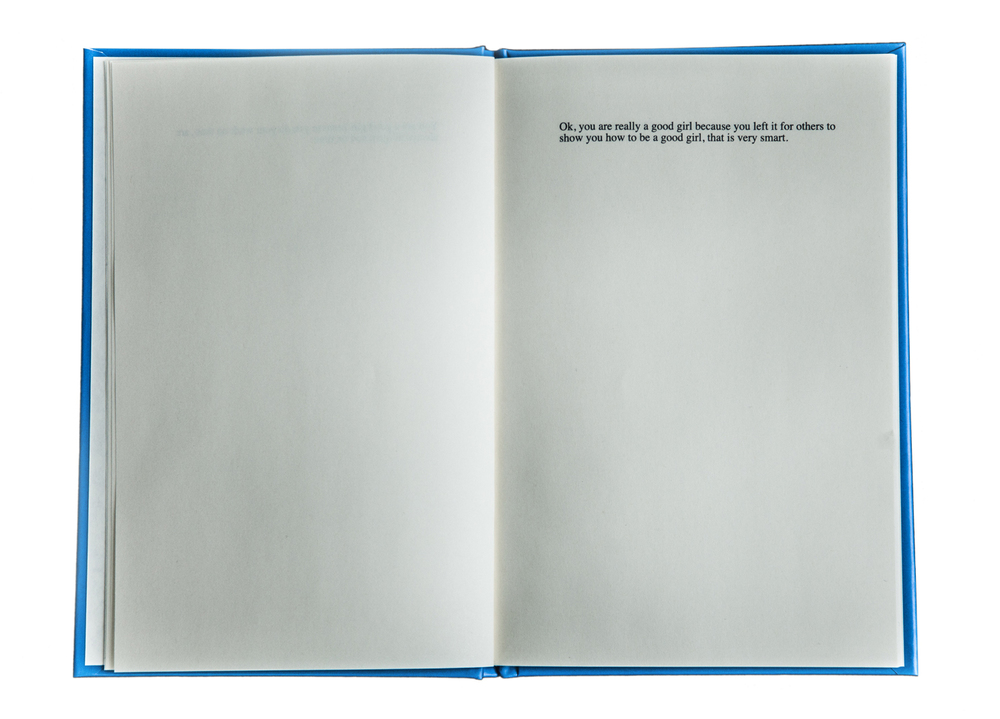
Excerpt from “Tell me why I’m a good girl”: “OK, you are really a good girl because you leave it for others to show you how to be a good girl, that is very smart.”
LS Can you talk about the relationship between these crowd-sourced projects and your photographs?
SB I made books and audio work because I wanted to be specific about certain story-lines, and I couldn’t be specific enough with photography. In photography, my questions weren’t accessible to viewers. This started to be a problem for me. With the books, the questions are usually the titles, so they are pretty central. But my photos and books and audio projects are similar in that they allude to a kind of withholding. I am taking things out of context. In the books, the text floats on the page with no reference to the emails the guys wrote me, the email address, etc.; it is removed from its original context. But more than that, the actual texts, the excerpts, are just that–excerpts. Often, the misuse of punctuation suggests new meanings, or duality, in the mens’ responses. Sometimes even simple answers seem like they could mean more than one thing, almost like the idea is pointing in two different directions. This also occurs in the voicemails, where they say things like, “I love you honey, I want to marry you. Call me sometime, maybe.” I suppose I am withholding both information and clarity in the way I choose to decontextualize these elements. It’s hard to pinpoint in my photographs, but I am going for the same type of tension. I try to highlight the strangeness of mundane things that suggest duality and contradiction. In both ways of working, a big part of my thinking has to do with coming up against what I don’t know and trying to use photos or texts to figure it out.
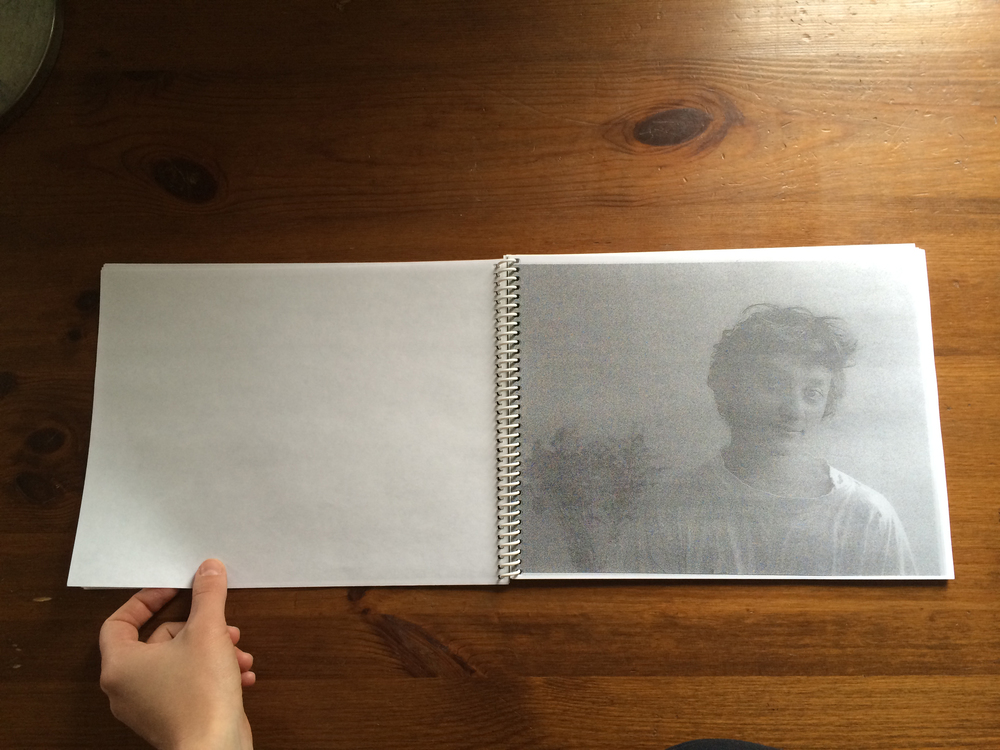
How long does it take to forget a face, 2013. Softcover book, 8.5×11 in., 43 pages
LS Structure is another big element in your work. Your photobook, How long does it take to forget a face, is a sort of animated still image, like a flipbook. Structurally, it is almost the opposite of your video piece, Moving Stills, which freezes most of the action within a still frame. Could you talk about your interest in playing with structure?
SB I like the interplay of a very hard-to-answer question and the simplicity of this book design–plain white cover, 8.5×11 computer paper pages. The structure is sort of illusory. The book format has some authority, which maybe gets undermined by the difficult question.
LS Undermined how?
SB When you reach the book’s end, you aren’t any closer to answering the question–it kind of leaves you with nothing. The book is about making something into nothing. After looking at it, you still don’t know the answer. This is something I strive for in my work.
